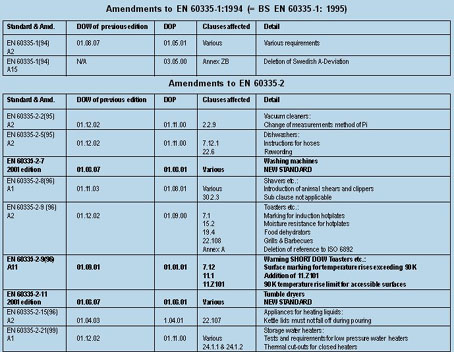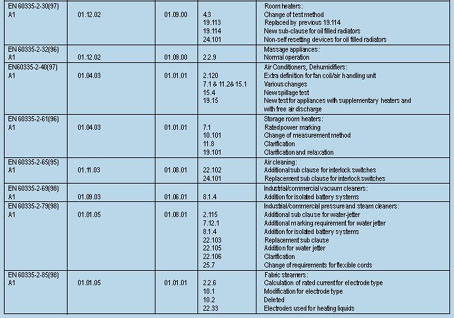|
EN 60335 – Safely Complying By Mike Cowan, Quality & Standards Manager, BEAB
Mike Cowan, Quality & Standards Manager from the British Electrotechnical Approvals Board (BEAB), takes a look at the EN 60335 Standard, its complexities and the importance of keeping up to date with the latest standards and relevant amendments. The harmonised standard EN 60335 covers the safety of household appliances (predominantly white goods) and similar electrical appliances with a rated voltage not more than 250 V for single-phase appliances and 480 V for other appliances. In addition, appliances not intended for normal household use, but which nevertheless may be a source of danger to the public, such as appliances intended to be used by laymen in shops, in light industry and on farms, are within the scope of this standard. The standard is divided into a Part One, which provides generic guidelines, and a series of Part Twos, which are product specific, advising of specific requirements for individual products. The essential safety requirements of the following European Directives, which could be applicable to household and similar appliances, are covered by the EN 60335 series:
- 73/23/EEC – Low Voltage Directive - 89/392/EEC – Machinery Directive - 89/106/EEC – Construction Products Directive
The public’s expectations of safety levels have risen considerably in recent times. This has led to an increase in the content of European Safety Standards, which are often complex. Manufacturers need to keep a constant track of the issue of new standards and amendments to these standards - which can be a minefield for those companies with hundreds of products in their portfolios. Many standards are issued each year and awareness of the Date of Withdrawal (DOW), published with each standard, is important. The DOW is the date by which any product being manufactured must be compliant with the new standard or amendment, if presumption of conformity to the above directives is to be maintained. Products that do not comply, effectively lose their presumption of conformity at the DOW. In recent years, the time allowed for an amendment to be incorporated into a product has reduced sharply, with the average DOW in Europe now two years from the Date of Publication (DOP) - as opposed to an average of five years previously. The DOP is the date by which every Member State of the European Union must publish the text of the new standard or amendment. Two years may sound like a reasonable time span for a manufacturer to evaluate the standard or amendment, however it must be considered that this affects not only products which will continue in production but also those under development. This also assumes that the standard or amendment is actually published on time, which is not always the case. During 2001, the EN 60335 series has seen 40 standards and amendments published, with 24 dates of withdrawal notified within this time. There are already 22 dates of withdrawal notified for 2002. These changes need to be tracked very closely to ensure that manufacturers’ CE marking declarations remain valid, and ultimately that their electrical products are safe for use. The importance of keeping abreast of safety standards, such as EN 60335, was exemplified in a legal case in the UK involving the surface temperatures for toasters. The outcome of the case led to the UK declaring to the European Commission that the Standard EN 60335-2-9(96) needed to be amended. As a result of this, the European Commission recognised that the Standard did not adequately address all the essential safety requirements of the Low Voltage Directive, which led to a change in the Standard via Amendment A11. As a result of this, manufacturers of toasters had to limit the temperature rise of the surface casing to 90 K, when previously there had been no limit. The official date of publication (1 January 2001) was quickly followed by a date of withdrawal of 1 September 2001. This rapid introduction of the amendment was necessary to ensure consumer safety. The case also highlighted that ‘a product could be found to be unsafe under the Regulations (The Electrical Equipment Safety Regulations 1994) even though it complied with a harmonised safety standard’. Manufacturers should be aware that it is their responsibility to ensure that their products meet the requirements of the relevant European Directives and, more importantly, that a CE Marking declaration of conformity, based solely on compliance with obsolete standards, does not carry a presumption of conformity with Directives. Such a declaration might not stand up in a court of law. To help manufacturers deal with the complexities involved with standards such as EN 60335, BEAB has developed an early warning system to advise them about the withdrawal of standards that may affect the approval status of their products. Using this system BEAB is able to give up to a year’s advance warning of any date of withdrawal. Administered on a product-by-product basis, it enables each manufacturer to decide how to manage the change prior to the date of withdrawal. Updating Approval can vary from a minor amendment to file records and re-issue of an approval certificate, to limited re-testing targeted at the relevant standard(s) or, in some cases, to a full re-test when changes to the standard make this necessary. The attached table outlines the latest amendments to EN 60335-1:1994 (=BS EN 60335-1:1995) and associated Part Two standards as of June 2001. Should you need further information or advice please contact BEAB on 01483 455466, email info@beab.co.uk, or visit www.beab.co.uk
|

